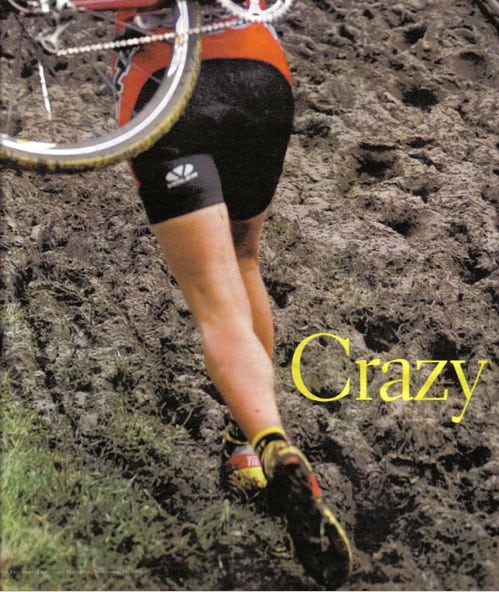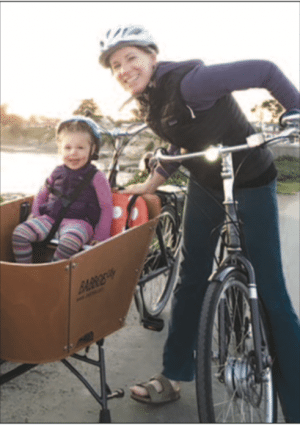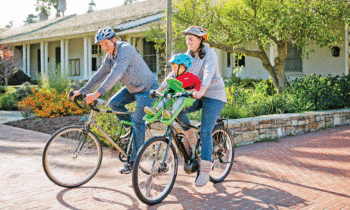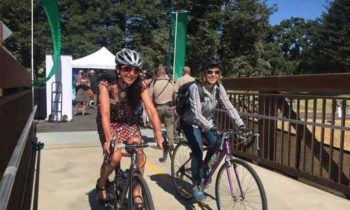November 28, 2004
San Francisco Chronicle Magazine
By Karen Kefauver
Christine Vardaros finds cyclo-cross races thrilling in even the toughest conditions: “What I love most is really, really bumpy terrain and bitterly cold weather. One of my most enjoyable races was in Kansas City. It was negative 40 degrees with a wind chill of 6 degrees. Half the course was on snow, the other half on ice. Many people were taken away in an ambulance with frostbite, but I loved it. With the wind flying in your face, you could barely breathe, riding as hard as you can at 2 miles an hour.”
“I’m a weird one,” admitted Vardaros, 35, of Mill Valley. The world-class racer also fondly recalled a World Cup race in the Netherlands where “we were running 100 meters with our bikes on our shoulders through knee-deep mud. It was great.” Vardaros is one of a handful of professional Velo Bellas who are promising contenders at this year’s national cyclo-cross race scene. (Based in Monterey, the all-women Velo Bella team includes dozens of cyclists across the country with varying skill levels, including this author, a recreational racer).
The Bay Area is one of the country’s hot spots for cyclo-cross racing, along with the Northeast and Pacific Northwest. Every weekend from September through January at venues stretching from Monterey to Sacramento, scores of local riders compete in 30- to 60-minute cyclo-cross races, which blend mountain bike and road-racing skills. Novice and pro bike racers alike test their fitness and technique and become part of a close-knit community that is unique to the sport.
Home to a dozen elite athletes who have excelled in cyclo-cross events at the national and international levels, the Bay Area and Central Coast boast a disproportionate number of the country’s best female racers. “I have given a big chunk of my life to cyclo-cross,” said Rachel Lloyd, 29, of Fairfax, who has been racing nearly a decade and has qualified three times to race at the world championships. “It’s got an old-school feel to it,” she said of the appeal. “A wacky, super-fun, rad, community feel.”
Another top cyclo-cross racer, Gina Hall, 37, said, “It’s very intense because you have to incorporate running and cycling techniques. It’s very important to have not just strength, but to have efficient technique,” said Hall, who has competed for seven years and recently moved from Richmond to Ashland, Ore. “Racing in Europe last year with the top women in the world, I learned a lot about racing efficiently.”
Commonly called cross, the sport has a huge, NFL-like following in Europe, where it originated as a way for bicycle road racers to stay fit during the winter off-season. Nasty weather is no hurdle for cyclo-cross racers; the more mud, rain, snow and ice, the better. On rainy days, cyclists flash dirt- splattered grins, crossing the finish line covered in mud from their shoes (duct taped to their feet to prevent losing them in the muck) to their helmets.
Cyclo-cross racing looks like a bizarre backwoods ballet. Balancing their two-wheeled partners on their shoulders while leaping over barricades and running up steep hills, competitors charge through the obstacle course at top speed. Including paved and dirt surfaces, sand pits, mud bogs and tree roots, cyclo-cross courses are designed to force athletes to dismount their bikes multiple times during the race.
“What I like is that you get to use road-racing tactics in a short course and all the dirt-handling skills of mountain biking. It’s the best of both combined,” said Barbara Howe, 28, of Larkspur, a pro mountain biker who is shifting her attention to cyclo-cross as a member of the Velo Bella elite squad. “It has more of a grassroots feel like mountain biking used to.”
Fancy footwork is required to jump on and off the bike while it is moving and to hoist the bicycle over barriers while running. One misstep can lead to disaster: crashing into a barricade, being trampled by fellow riders after a fall or getting a flat tire.
“Cross is such a test of agility, concentration and intensity,” said Vardaros of Mill Valley, who has been racing as a professional cyclo-cross specialist for nearly 10 years and has reached the world championships twice. “By far, it’s the most elegant of all cycling disciplines when executed properly. It can be the ugliest cycling sport you have ever witnessed when people miscalculate the barriers and fly into a face plant.”
The racer who completes the most laps in the allotted time period (30 minutes for beginners, 45 minutes for intermediate and 60 minutes for pros) wins the race. Each lap is about 1 1/2 miles. Riders are awarded points at each race according to their finishing times; culminating in series winners who have racked up the most points.
“It is an extreme sport in a way,” said Vardaros, Howe’s teammate on Velo Bella. “It’s not for the weak. It’s a challenge. It’s not just riding your bike around in circles. It requires you to run, jump and be quick. Mountain bike and road-race skills have to come together and be perfect for 45 minutes. It’s a very precise and beautiful sport. The thrill you get when it all comes to together can’t be compared to any other high for me.”
The sport is growing in America, according to USA Cycling spokesman Andy Lee. “As far as the popularity of cross goes, the United States has more internationally sanctioned events than any other country in the world, and that says a lot when compared to countries like Belgium, where cross is like a religion,” said Lee. “[The number of sanctioned events] is a testament to the quality of races being put on by numerous promoters.”
Lee also noted the return of a high-profile U.S. national cyclo-cross series after two years’ hiatus. “This year, we see the return of a big name series, the U.S. Gran Prix of Cyclocross. The national event is being resurrected with a series of six events on both the East and West coasts.”
Though none of the Gran Prix events are scheduled for California, the Bay Area has recently played host to two U.S. national championships — at the Presidio in 1999 and in Napa in 2002, during a torrential downpour. This year’s nationals return to Portland, Ore., before moving to New England in 2005.
“The most spectacular event I have ever attended was cyclo-cross nationals in San Francisco,” Vardaros recalled. “There were 25,000 fans packed in this little, itty-bitty space. It was great. People are still talking about the crowds and the course. The race was so compact and right in the middle of a major city.”
Whether held downtown, at fairgrounds or at a high school field, the races attract spectators who are an important aspect of the sport. “Of all the types of bike racing, I love cyclo-cross the most because of the fan support,” said Gina Hall, whose cyclo-cross races have taken her around the country and the globe. “There are people all over the course.”
While standing only inches away from the action, fans yell encouragement to riders. “Up, up, up!” they bellow at panting racers dashing up short, steep hills called run-ups. Cheers of “Go, Dad!” and “Good job, Mom!” come from families who pack picnics, chairs and umbrellas and stay for the day. The fan encampment along the sidelines looks like a tailgate party with bikes instead of cars. Since races start hourly, many competitors stay after their events to cheer friends on.
“With cyclo-cross, it’s such a small circuit where spectators are right there,” said Lloyd, who has made multiple trips to compete at the world championships alongside Vardaros and Hall. “It’s so exciting because you can see so much of the race develop, unlike other road-bike racing.”
Some of this year’s drama in cyclo-cross will take place in the elite women’s division, with an expected changing of the guard amongst the top rung of world-class racers: Rachel Lloyd of Fairfax, Gina Hall formerly of Richmond, and Carmen D’Aluisio of Watsonville have each announced intentions to drastically scale back cyclo-cross racing or, gasp, retire. When pressed for details, each has implied, “Never say never,” but change is certainly afoot amongst these women who have shared the spotlight for a decade with perennial champions Alison Dunlap and Ann Knapp.
“It takes the upper echelons retiring for new faces to appear,” said Carmen D’Aluisio, 35. “I think there are a handful of women who could step it up.”
Those eager to rise to the next level, ideally all the way to the world championships in St. Wendel, Germany, in January, include Vardaros and Howe. “We have the opportunity,” said Howe, who would like to place in the top five finishers at the national championship race this December. She also would like for herself and her teammates to qualify for the world championships. “We are traveling to over a dozen UCI-ranked races across the country.”
When they are not on the road, the women will polish their form at regional races, including the Bay Area Super Prestige Cyclo-Cross Series. Returning for its second season, the race series features five events, held at spots like Candlestick Recreation Area and Coyote Point. “This season we want to make sure we can give cross racers a high-quality racing experience,” said race director Tom Simpson of Pilarcitos Cyclesports. “There are very serious athletes there. We try to cater to their requirements as well the many who just want to have fun, tearing around for 45 minutes doing whatever best they can. … Seventy-five percent of our riders are there for fun, not to get a spot on the worlds team, so we make sure also that amateur racers have an equally good time.”
At the opening Pilarcitos race, held Sept. 26 at Candlestick Point, Thomas Fox, 42, of Stintson Beach, and his 11-year-old son, Bjorn, entered their first cyclo-cross races. “It is challenging,” said an exuberant Fox, at the end of his 30-minute beginner’s men event. “You have to have technical control of the bike,” said Fox, who crashed on a gravel hairpin turn when his tires slid. Despite the fall, Fox said, “I will absolutely do it again.”
While many novices race on their mountain bikes, Fox rode a red Cannondale cyclo-cross bike, which looks and functions similarly to a road bike, with dropped handlebars and a lightweight frame, but with add-ons of knobby tires for better traction and cantilever brakes, which are less susceptible to clogging with mud. “It’s fun,” agreed Bjorn. “I was doing my best. Jumping over the barriers was hard. That’s where everybody passed me,” said the redhead, who still walked away with a medal in the junior division.
“At our final event, we will crown champions. I think that the junior podium finishers will get to open a bottle of sparkling apple juice, to practice for age 21 when they can open champagne,” said promoter Simpson, whose family helps him put on the races. “I am really interested in promoting events close to heart of Bay Area.”
With a road-racing experience that started in the mid-’70s and 20-plus years involvement in organizing races, Simpson has watched the cross scene grow and helped it flourish with this series — and his signature voice as a professional race announcer.
One challenge to cyclo-cross promoters like Simpson and his friend, Robert Leibold of Velo Promo, another longtime cyclo-cross race director who runs the East Bay CX Series, is getting the word out about the sport. Cyclo- cross remains mysterious, even to many cycling enthusiasts who participate in other forms of bike racing. “It is still relatively a niche sport within a niche sport,” said Lee of the status of cyclo-cross in America. “If you ask most people on the street, they know about mountain biking or road biking, but if you say cyclo-cross, they say, ‘What?’ ”
Yet in the Bay Area, due to the number of events, talented racers and enthusiastic fans, cyclo-cross enjoys a large number of passionate devotees. Simpson estimated attendance at 1,000 fans and athletes per event during the first year of his cyclo-cross series. Attracted by a combination of factors — curiosity, fitness and love of cycling — athletes and fans come together at events week after week, to form a friendly community, even while maintaining competitive rivalries.
“I love racing cross because it really hones my other skills like running, getting on and off the bike, technical handling, race tactics, not to mention the high end fitness it brings,” said mountain bike Olympian Mary McConneloug, who grew up in Fairfax and e-mailed from her home in Massachusetts after returning from Athens. “I love how short the races are. I also enjoy the social aspect; cyclists sure are a special breed.”
The unique spirit at cyclo-cross races appeals to amateurs and pros alike. “It’s a fun bunch of people who come out every weekend,” said Carmen D’Aluisio, who has retired from elite racing this year. While it is growing in popularity, the sport retains elements of its cult status, with men racing in dresses and at least one woman wearing a gorilla suit. Maybe cyclo-cross does not need its own Lance Armstrong. After all, when 11-year-old Bjorn was asked about his bicycling inspirations, he said, “I don’t need role models. I just want to be me.”
Perhaps that is what cross is all about.
Resources
To learn more about the sport of cyclo-cross and to find a calendar of events, check out the following Web sites:
Bay Area race calendar and rides: www.ncnca.org/cyclocross/2004/calendar.html
All that you need to know about cyclo-cross from the Napa Valley Velo Team: members.aol.com/napavelo/cross.htm
Details on Velo Bella, an all-women’s race team: www.velobella.org/rides_cyclocross.htm
Karen Kefauver is a freelance writer living in Santa Cruz. She can be reached at karen@karenkefauver.com









